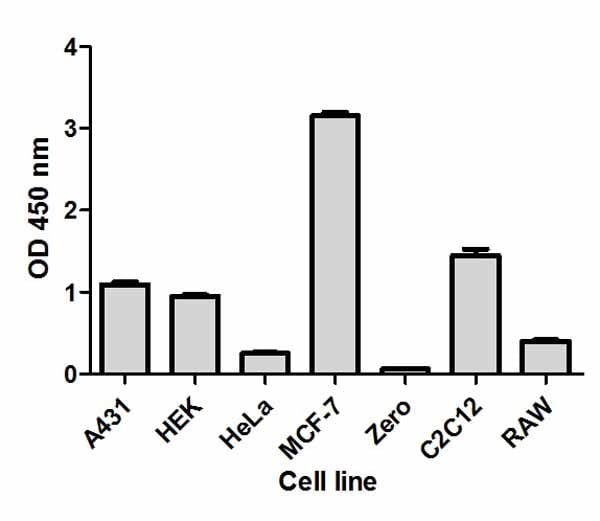p70S6K (pT389) ELISA Kit (ab176651)
Key features and details
- One-wash 90 minute protocol
- Sensitivity: 1 ng/ml
- Range: 1 ng/ml - 100 ng/ml
- Sample type: Cell Lysate, Tissue Homogenate
- Detection method: Colorimetric
- Assay type: Semi-quantitative
- Reacts with: Mouse, Human
Overview
-
Product name
p70S6K (pT389) ELISA Kit -
Detection method
Colorimetric -
Precision
Intra-assay Sample n Mean SD CV% MCF7 extract 6 3.3% Inter-assay Sample n Mean SD CV% MCF7 extract 3 2.9% -
Sample type
Cell Lysate, Tissue Homogenate -
Assay type
Semi-quantitative -
Sensitivity
1 ng/ml -
Range
1 ng/ml - 100 ng/ml -
Assay time
1h 30m -
Assay duration
One step assay -
Species reactivity
Reacts with: Mouse, Human
Predicted to work with: Rat
-
Product overview
Abcam’s p70S6K (pT389) in vitro SimpleStep ELISA™ (Enzyme-Linked Immunosorbent Assay) kit is designed for the semi-quantitative measurement of p70S6K (pT389) protein in Human and mouse cells.
The SimpleStep ELISA™ employs an affinity tag labeled capture antibody and a reporter conjugated detector antibody which immunocapture the sample analyte in solution. This entire complex (capture antibody/analyte/detector antibody) is in turn immobilized via immunoaffinity of an anti-tag antibody coating the well. To perform the assay, samples or standards are added to the wells, followed by the antibody mix. After incubation, the wells are washed to remove unbound material. TMB substrate is added and during incubation is catalyzed by HRP, generating blue coloration. This reaction is then stopped by addition of Stop Solution completing any color change from blue to yellow. Signal is generated proportionally to the amount of bound analyte and the intensity is measured at 450 nm. Optionally, instead of the endpoint reading, development of TMB can be recorded kinetically at 600 nm.
-
Notes
Abcam has not and does not intend to apply for the REACH Authorisation of customers’ uses of products that contain European Authorisation list (Annex XIV) substances.
It is the responsibility of our customers to check the necessity of application of REACH Authorisation, and any other relevant authorisations, for their intended uses. -
Platform
Microplate
Properties
-
Storage instructions
Store at +4°C. Please refer to protocols. -
Components 1 x 96 tests p70S6K (pT389) Capture Antibody 1 x 3ml p70S6K (pT389) Detector Antibody 1 x 3ml 10X Wash Buffer PT 1 x 15ml 50X Cell Extraction Enhancer Solution 1 x 1ml 5X Cell Extraction Buffer PTR 1 x 10ml Lyophilized p70S6K Control Lysate 1 vial Plate Seal 1 unit SimpleStep Pre-Coated 96-Well Microplate (ab206978) 1 unit Stop Solution 1 x 12ml TMB Substrate 1 x 12ml -
Research areas
-
Relevance
The protein p70 S6 kinase is critical for cell cycle progression and cell survival. In response to mitogen stimulation, p70 S6 kinase activation up-regulates ribosomal biosynthesis and enhances the translational capacity. The p70S6K phosphorylates the S6 protein of the 40S subunit of the ribosome. This kinase was first characterized as an insulin/mitogen-activated protein kinase, whose major known substrate is the 40 S ribosomal subunit protein S6. The p70 S6 kinase is activated by diverse stimuli through a multi-site phosphorylation such as Thr-252 and Ser-434. In Alzheimer's Disease (AD), p70 S6 kinase activation is associated with PHF-tau (hyperphosphorylated tau) accumulation. In non-neuronal cells, p70 S6 kinase have been shown to regulate actin polymerization. -
Cellular localization
Cell junction › synapse › synaptosome By similarity. Mitochondrion outer membrane. Mitochondrion. Note: Colocalizes with URI1 at mitochondrion. Isoform Alpha I: Nucleus. Cytoplasm Isoform Alpha II: Cytoplasm -
Alternative names
- 70 kDa ribosomal protein S6 kinase 1
- p70 alpha
- p70 S6 kinase alpha
see all -
Database links
- Entrez Gene: 6198 Human
- Entrez Gene: 72508 Mouse
- Entrez Gene: 83840 Rat
- Omim: 608938 Human
- SwissProt: P23443 Human
- SwissProt: Q8BSK8 Mouse
- Unigene: 463642 Human
- Unigene: 394280 Mouse
see all
Images
-
SimpleStep ELISA technology allows the formation of the antibody-antigen complex in one single step, reducing assay time to 90 minutes. Add samples or standards and antibody mix to wells all at once, incubate, wash, and add your final substrate. See protocol for a detailed step-by-step guide.
-
Example of a typical p70S6K (pT389) cell lysate dilution series. Raw data values are shown in the table. Background-subtracted data values (mean +/- SD) are graphed.
-
Example of a typical p70S6K (pT389) recombinant protein standard curve. The proportion of total protein that is phosphorylated is unknown - data is indicative only. Raw data values are shown in the table. Background-subtracted data values (mean +/- SD) are graphed.
-
Linearity of dilution in representative sample matrices. Cellular lysates were prepared at 3 concentrations in common media containing 1 x Cell Extraction Buffer PTR. Data from duplicate measurements of p70S6K (pT389) are normalized and plotted.
-
Cell line analysis for Total p70S6K from 100 µg/mL preparations of cell extracts. Data from triplicate measurements (mean +/- SD) are plotted and compared to 1X Cell Extraction Buffer PTR (zero).
-
Induction of p70S6K (pT389) phosphorylation in MCF-7 cells in response to insulin treatment. MCF-7 cells were cultured in 96-well tissue culture plates, serum-starved and treated (10 min) with a dose-range of insulin before cell lysis. Data from quadruplicate measurements of p70S6K (pT389) are plotted and compared against total p70S6K protein levels. Comparative p70S6K (pT389) and p70S6K (Total) data also shown by Western Blot.


















